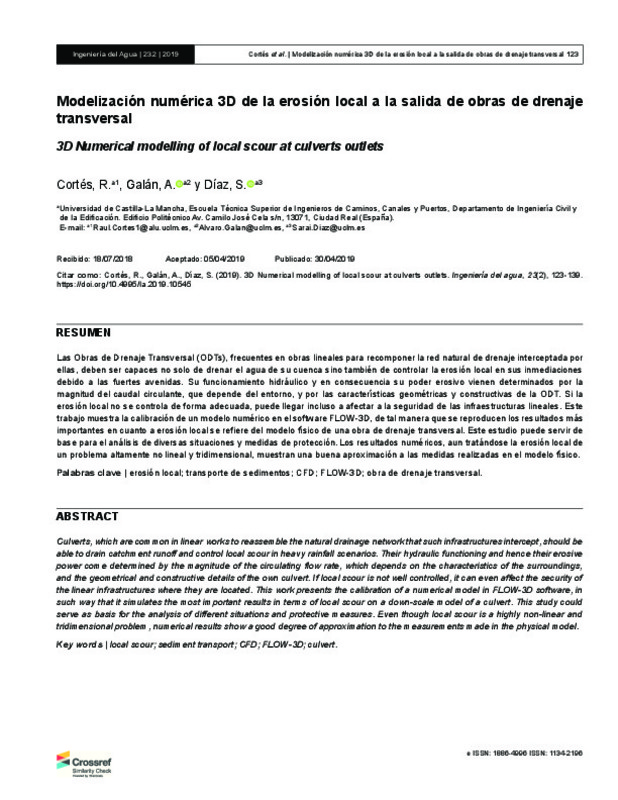Abdelaziz, S., Bui, M.D., Rutschmann, P. (2010). Numerical simulation of scour development due to submerged horizontal jet. Proceedings of River Flow 2010, September 8-10, Munich, Germany, 1597-1604.
Abida, H., Townsend, R. (1991). Local scour downstream of box-culvert outlets. Journal of Irrigation and Drainage Engineering, 117(3), 425-440. https://doi.org/10.1061/(ASCE)0733-9437(1991)117:3(425)
Abt, S.R., Thompson, P.L., Lewis, T.M. (1996). Enhancement of the culvert outlet scour estimation equations. Transportation Research Record: Journal of the Transportation Research Board, 1523, 178-185. https://doi.org/10.3141/1523-22
[+]
Abdelaziz, S., Bui, M.D., Rutschmann, P. (2010). Numerical simulation of scour development due to submerged horizontal jet. Proceedings of River Flow 2010, September 8-10, Munich, Germany, 1597-1604.
Abida, H., Townsend, R. (1991). Local scour downstream of box-culvert outlets. Journal of Irrigation and Drainage Engineering, 117(3), 425-440. https://doi.org/10.1061/(ASCE)0733-9437(1991)117:3(425)
Abt, S.R., Thompson, P.L., Lewis, T.M. (1996). Enhancement of the culvert outlet scour estimation equations. Transportation Research Record: Journal of the Transportation Research Board, 1523, 178-185. https://doi.org/10.3141/1523-22
Bohan, J. (1970). Erosion and riprap requirements at culvert and storm-drain outlets. Technical report U.S Army Engineer Waterways Experiment (Hydraulic Laboratory Investigation), Vicksburg, Mississippi.
Burkow, M., Griebel, M. (2016). A full three dimensional numerical simulation of the sediment transport and the scouring at a rectangular obstacle. Computers and Fluids, 125, 1-10. https://doi.org/10.1016/j.compfluid.2015.10.014
Campos, J., González, J., Díaz, S., Galán, A. (2017). Metodología para la evaluación del riesgo y la priorización de inversiones en el mantenimiento de obras de drenaje transversal. V Jornadas de Ingeniería del Agua, 25-26 Octubre, A Coruña, España.
Chatterjee, S.S., Ghosh, S.N., Chatterjee, M. (1994). Local scour due to submerged horizontal jet. Journal of Hydraulic Engineering, 120(8), 973-992. https://doi.org/10.1061/(asce)0733-9429(1994)120:8(973)
Day, R.A., Liriano, S.L., White, W.R. (2001). Effect of tailwater depth and model scale on scour at culvert outlets. Proceedings of the Institution of Civil Engineers-Water, Maritime Engineering, 148(3), 189-198. https://doi.org/10.1680/wame.2001.148.3.189
Flow-Science, Inc. (2016). FLOW-3D User Manual, Release 11.2.0, United States.
Lim, S.Y. (1995). Scour below unsubmerged full flowing culvert outlets. Proccedings of the Institution of Civil Engineers Water, Maritime and Energy, 112, 136 149. School of Civil and Structural Engineering, Nanyang Technological University, Singapore. https://doi.org/10.1680/iwtme.1995.27659
Mehnifard, M.A., Dalfardi, S., Baghdadi, H., Seirfar, Z. (2015). Simulation of local scour caused by submerged horizontal jets with Flow-3D numerical model. Desert, 20(1), 47-55.
Mendoza, C., Abt, S.R., Ruff, J.F. (1983). Headwall influence on scour at culvert outlets. Journal of Hydraulic Engineering, 109(7), 1056-1060. https://doi.org/10.1061/(asce)0733-9429(1983)109:7(1056)
Roads and Traffic Authority. (2010). Culvert risk assessment guideline, version 3.02. NSW, Australia.
Sangdo, A., Hyeyun, K., Pierre, Y. (2015). Numerical modelling of local scour caused by submerged jets. Maejo International Journal of Science and Technology, 9(3), 328-343. https://doi.org/10.14456/mijst.2015.25
Sarathi, P., Faruque, M.A.A., Balachandar, R. (2008). Influence of tailwater depth, sediment size and densimetric Froude number on scour by submerged square wall jets. Journal of Hydraulic Research, 46(2), 158-175. https://doi.org/10.1080/00221686.2008.9521853
Sorourian, S., Keshavarzi, A., Ball, J., Samali, B. (2014). Blockage effects on scouring downstream of box culverts under unsteady flow. Australian Journal of Water Resources, 18(2), 180-190. https://doi.org/10.1080/13241583.2014.11465449
Zhang, Q., Zhou, X-L., Wang, J-H. (2017). Numerical investigation of local scour around three adjacent piles with different arrangements under current. Ocean Engineering, 142, 625-638. https://doi.org/10.1016/j.oceaneng.2017.07.045
[-]








